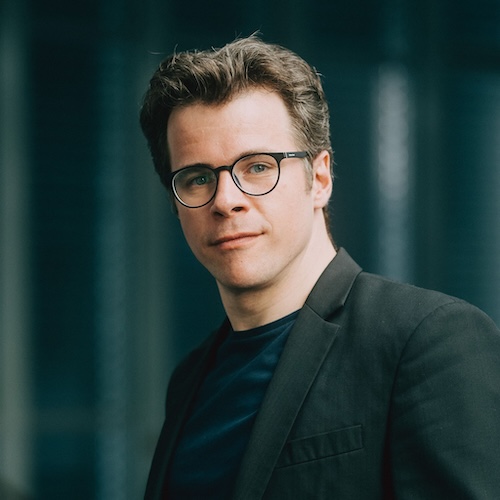Performances
Ma & Stott close long musical partnership in generous style in Boston
Yo-Yo Ma and pianist Kathryn Stott offered a fitting tribute to […]
Tetzlaff & Gerstein explore the radical side of Brahms and others for Celebrity Series
Arnold Schoenberg thought so highly of Johannes Brahms that he grafted […]
Retooled Quatuor Ébène in first-class form at Shriver Hall
The Quatuor Ébène was last heard locally in 2014 at the […]
Concert review
Hrůša, Bamberg Symphony deliver a memorable evening of Brahms and Wagner in Boston
There’s nothing like making up for lost time. That, on the one hand, is what the Bamberg Symphony did in their first Celebrity Series concert since 1983, delivering one of the meatiest—and most canon-centric—programs of the season Tuesday night atSymphony Hall in Boston.
Yet, across the 135-plus-minute appearance that opened their four-city U.S. tour, the orchestra and chief conductor Jakub Hrůša seemed intent to prove that musical familiarity needn’t breed complacency or contempt. Rather, with the right approach, the old—even the Germanic old of Richard Wagner, Johannes Brahms, and Robert Schumann—can be made fresh and new again.
That was certainly true of the night’s reading of Brahms’s Symphony No. 3. Written just after the composer turned fifty, its four movements are steeped in nostalgia and wistfulness. At the same time, the score abounds in rhythmic vitality, melodic warmth, and, especially in the middle movements, beguiling serenity.
Tuesday’s performance reveled in the Third’s punching energy. Hrůša drew out the first movement’s volatile, motoric extremes and sculpted the finale’s explosive climaxes into moments of exhilarating release.
For all its taut, snapping rhythms, though, his larger interpretation was anything but dogmatic. Rather, it was marked by flexibility and a certain rhetorical flair.
Both of the first movement’s principal themes were notable for their lilting qualities: even when floating above churning obbligatos, the music didn’t relinquish its dancing impetus. In the Andante, the second subject took on a conspicuous weightiness. When these materials returned in the finale, they stood out all the more powerfully. In the night’s context, it was as though the symphony’s various strands were actively conversing with each other.
Throughout, the Bambergers’ playing demonstrated impeccable balances—one could hear various inner voices emerging from the depths of the ensemble—refulgent tonal warmth, and bold dynamic contrasts. Evidently, the orchestra was fully at home in Symphony Hall’s acoustic: climacterics were full-bodied and weighty, yet miraculously lucid.
Indeed, in the Bavarian orchestra’s hands, this was music of real vitality and revelation. When the finale’s coda rolled around, it brought with it the sense of an enchanting, epic journey finally reaching home.
The strengths of the night’s Brahms largely carried over, in the orchestra at least, to Schumann’s Piano Concerto. Again, Hrůša ensured that rhythms were taut, tempos moved smartly (though with no shortage of rubato-infused phrasings), and the ensemble’s blend was faultless.
However, Lukáš Vondráček, the night’s soloist, proved something of an enigma. (Hélène Grimaud will play the Schumann in the orchestra’s subsequent performances in New York, Virginia, and Washington, D.C.)
The “indisputable winner” (as his bio styles it) of the 2016 Queen Elisabeth Piano Competition, Vondráček certainly had the concerto’s notes in hand. His account of the solo part was, generally, clean-textured and articulate.
Furthermore, much of his playing took on an inward quality. This approach lent the outing a chamber music-like aspect, which, in many regards, fits Schumann’s style well. Given the Bamberger’s responsiveness, the work’s exchanges between piano and orchestra took on an engaging sheen.
That said, Vondráček’s fundamentally anti-heroic tack was ultimately frustrating. Too often, the keyboard part sounded reined in and hampered. Rarely did the pianist convincingly match, let alone rise above, the orchestra in heft or dynamism.
In the first movement, Vondráček’s unaccompanied moments took on a predictably restrained, fitful demeanor. The outer thirds of the Intermezzo were mannered. Though the finale fared best, its boisterous episodes—or those that should have been—lacked presence and consistent projection.
Though the results were middling, Vondráček reaped a rowdy ovation and rewarded the crowd with a substantial encore in the form of Schumann’s C-major Arabesque. Here, finally, his playing came into its own: shapely, full-bodied, poetic.
Framing the Schumann and Brahms offerings were two curtain-raisers by Wagner. The Prelude to Act 1 from Lohengrin unfolded with a compelling sense of shape and a kaleidoscopic array of colors.
The Bamberger’s take on the Overture to Tannhäuser was likewise inviting. Here, plush, noble statements of the Pilgrim’s Hymn framed a bright, fresh rendition of the Venusberg music, the last replete with raucously reeling woodwind lines.
Afterwards, Hrůša and his band offered Brahms’s Hungarian Dances Nos. 18 and 21 as encores. Both were dispatched with an electrifying sense of ownership that, per the night’s remarkable simpatico between conductor, orchestra, and repertoire, was downright thrilling.
The Bamberg Symphony performs Friday at the Moss Arts Center in Blackwoods Virginia and Saturday at George Mason University in Fairfax. cfa.calendar.gmu.edu
Articles
Stephen Hough’s new concerto looks to the past as well as the future
Sir Stephen Hough’s response as to the inspiration for writing his […]
DG recordings from four celebrated pianists to close the musical year
Rachmaninoff: Piano Concertos Nos. 1-4; Rhapsody on a Theme of Paganini. […]
News
American Music Project to present a full 2024 season with three concerts
The American Music Project will mark its 10th anniversary in ambitious […]
Subscribe
![]() Subscribe via RSS
Subscribe via RSS
![]() Follow on Twitter
Follow on Twitter
